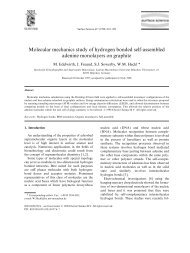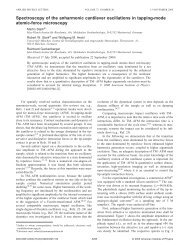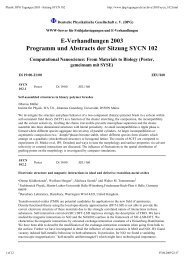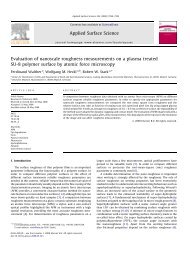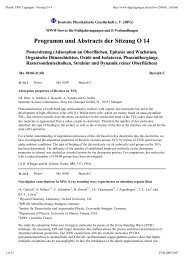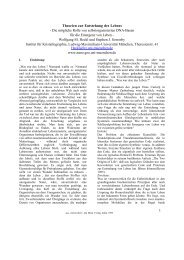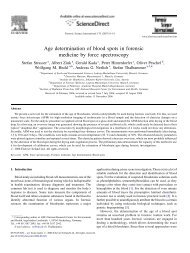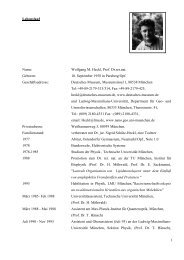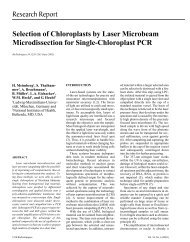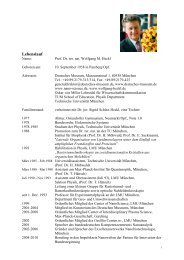Physik: DPG Tagungen - Sitzung O 28 - Nano-science.de
Physik: DPG Tagungen - Sitzung O 28 - Nano-science.de
Physik: DPG Tagungen - Sitzung O 28 - Nano-science.de
You also want an ePaper? Increase the reach of your titles
YUMPU automatically turns print PDFs into web optimized ePapers that Google loves.
<strong>Physik</strong>: <strong>DPG</strong> <strong>Tagungen</strong> - <strong>Sitzung</strong> O <strong>28</strong><br />
http://www.dpg-tagungen.<strong>de</strong>/archive/2004/o_<strong>28</strong>.html<br />
Bildkontrast empfindlich von <strong>de</strong>r ausgewählten Energie <strong>de</strong>r Elektronen abhängt. Die <strong>de</strong>rzeitige Begrenzung <strong>de</strong>r<br />
räumlichen (160nm) und zeitlichen Auflösung <strong>de</strong>r Metho<strong>de</strong> ist durch die Repetitionsrate (1kHz) <strong>de</strong>s anregen<strong>de</strong>n<br />
Lasers bedingt.<br />
O <strong>28</strong>.35 Poster Mi 16:00 Bereich C<br />
Growth of Platin <strong>Nano</strong>wire Networks on Nafion<br />
•M. Elbahri, J. Franc, O.C. Aktas, R. A<strong>de</strong>lung und F. Faupel<br />
Lehrstuhl für Materialverbun<strong>de</strong>, Technische Fakultät <strong>de</strong>r CAU Kiel<br />
The Nafion polymer, produced by the Dupont company, is still the most prominent membrane material for the<br />
commercial polymer electrolyte fuel cell (PMFC). Usually, the Nafion membrane is sandwiched by two catalytic<br />
layers, consisting of a metal-Nafion-carbon mixture in or<strong>de</strong>r to provi<strong>de</strong> catalytic activity as well as electrical and<br />
proton conductivity. It turns out that most of the Platinum doesn't contribute to the catalytic efficiency, which<br />
increases the total cost for the PMFC-fuel cell. An alternative approach might be a catalytic layer formed by a<br />
Pt-nanowire network. We present here a strategy to <strong>de</strong>posit Pt in the form of a nanowire networks. Therefore<br />
we used sputter <strong>de</strong>posited Pt on a vacuum <strong>de</strong>posited amorphous carbon mask layer. We show different<br />
Pt-nanowire networks generated on the Nafion surface and discuss the mechanisms that tune the network<br />
parameters like nanowire dimensions and mesh width.<br />
The authors thank the Technologiestiftung Schleswig-Holstein for supporting the project.<br />
O <strong>28</strong>.36 Poster Mi 16:00 Bereich C<br />
Imaging of optical near fields of nanostructures with fs laser pulses<br />
•Juliane Birk, Johannes Boneberg und Paul Lei<strong>de</strong>rer<br />
Universität Konstanz, FB <strong>Physik</strong>, LS Lei<strong>de</strong>rer, SFB 513, 78457 Konstanz<br />
The optical properties of nanostructures are a topic of interesting investigations. In analogy to the near fields<br />
around a Hertz dipole we expect near fields in the surrounding of all nanostructures. Up to now they were<br />
analysed with the scanning near field optical microscope (SNOM). We want to introduce an alternative method<br />
to image near fields with intensive short laser pulses. The intensity is adjusted to values where the substrate far<br />
from the particle is not affected. Nevertheless, the surface around and below the particle can be ablated, due to<br />
the local intensity enhancement in the optical near field. After the laser pulse the modified surface is imaged with<br />
atomic force microscopy (AFM) and thus the optical near fields of different nanostructures on several<br />
substrates, for example silicon, can be studied. A few examples of the near fields of various nanostructures are<br />
shown.<br />
O <strong>28</strong>.37 Poster Mi 16:00 Bereich C<br />
Infrared-optical properties of Cu nanoparticles on CaF 2 (111)<br />
•Birgit Gehring, Andreas Priebe und Annemarie Pucci<br />
Kirchhoff-Institut für <strong>Physik</strong>, Im Neuenheimer Feld 227, D - 69120 Hei<strong>de</strong>lberg<br />
Using IR spectroscopy the growth of Cu nanoparticles on UHV-cleaved CaF 2 (111) was investigated in situ.<br />
Relative transmission spectra informed about the dynamic conductivity of the nanoparticle film and about the<br />
influence of the substrate temperature on the percolation threshold.<br />
In the range from about 1000 cm -1 up to about 2500 cm -1 a relative transmission > 100 % was observed for Cu<br />
coverage below percolation, which corresponds to an anti-reflection effect. The magnitu<strong>de</strong> of this effect<br />
<strong>de</strong>pends on the growth temperature.<br />
For certain average Cu thicknesses we exposed CO at a sample temperature of about 100 K. The CO adsorption<br />
on different Cu facets was studied by IR transmission spectroscopy. The morphology of the nanoparticle layer<br />
13 of 32 07.06.2009 22:14



